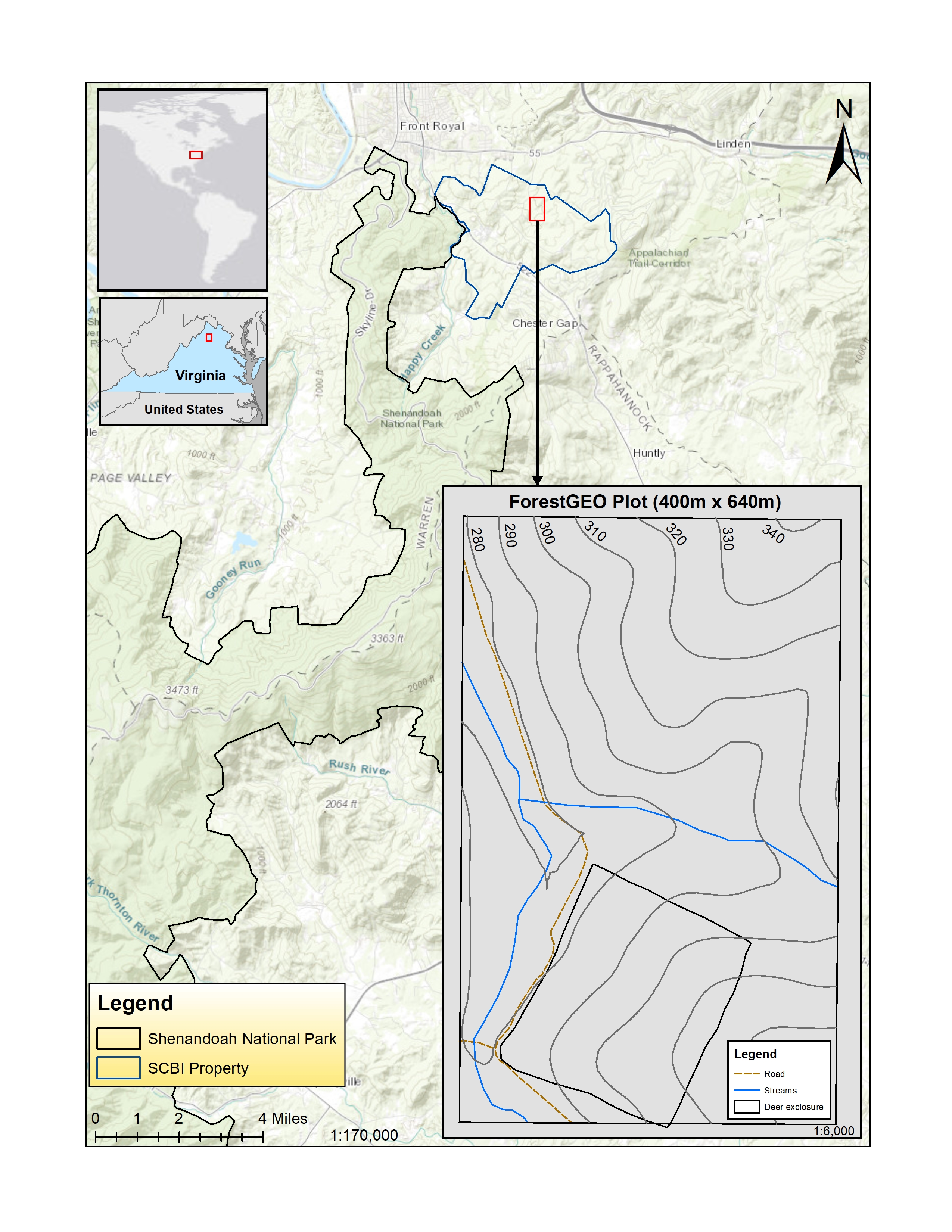Chapter 2 Physical Environment
2.1 Geographic location
The SCBI ForestGEO Large Forest Dynamics Plot is located within the Smithsonian Conservation Biology Institute (SCBI) in Virginia, USA (38\(^\circ\) 53’36.6“N, 78\(^\circ\) 08’43.4”W) located at the intersection of the Blue Ridge, Ridge and Valley, and Piedmont physiographic provinces and to the northwest of the Shenandoah National Park (Fig. 1).The site lies in the core Oak-Chestnut/Appalachian Oak region, which includes the ridges of the Appalachian mountain range from northern Georgia to southern Maine in the USA (Bourg et al. 2013).
The dimensions of the 25.6 ha SCBI plot are 640 x 400 meters, divided on a grid of 640 20 x 20 meters quadrats. Located at the south-east corner of the plot, there is a 4-ha fenced area erected in 1990 to exclude white-tailed deer (Odocoileus virginianus). This deer exclusion area has been part of a regional study on deer impacts in forest communities and invasive plants dispersion (Averill et al. 2017; Bourg et al. 2017; Heckel et al. 2010; McShea and Rappole 1992; McGarvey et al. 2013). Elevations range from 273 to 338 meters above sea level (masl) with a topographic relief of 65m (Fig. 1, insert)

Figure 1. Location of the SCBI ForestGEO Large Forest Dynamics Plot
2.2 Climate
The SBI plot is located in a mature (> 100 year) and young (< 40 year) secondary mixed deciduous forest, with a mean annual temperature of 12\(^\circ\)C and a mean annual precipitation of 1001 mm (data from 2009-2014 based on a local weather station located just outside the plot). According to the Koppen-Geiger biome classifcation, the plot falls within the Cfa zone, characterized as humid subtropical/midlatitude with significant precipitation year-round. Natural disturbances at the plot consist primarily of wind and ice storms (Anderson‐Teixeira et al. 2015).
Climate data from the weather tower adjancet to the plot and managed by primary investigators can be access through a public GitHub repository here. Other multiple climatic data products are also available in the NEON website for the SCBI core site here
References
Anderson‐Teixeira, Kristina J., Stuart J. Davies, Amy C. Bennett, Erika B. Gonzalez‐Akre, Helene C. Muller‐Landau, S. Joseph Wright, Kamariah Abu Salim, et al. 2015. “CTFS-ForestGEO: A Worldwide Network Monitoring Forests in an Era of Global Change.” Global Change Biology 21 (2): 528–49. https://doi.org/10.1111/gcb.12712.
Averill, Kristine M, David A Mortensen, Erica A H Smithwick, Susan Kalisz, William J McShea, Norman A Bourg, John D Parker, et al. 2017. “A Regional Assessment of White-Tailed Deer Effects on Plant Invasion.” AoB Plants 10 (1). https://doi.org/10.1093/aobpla/plx047.
Bourg, Norman A., William J. McShea, Valentine Herrmann, and Chad M. Stewart. 2017. “Interactive Effects of Deer Exclusion and Exotic Plant Removal on Deciduous Forest Understory Communities.” AoB PLANTS 9 (5). https://doi.org/10.1093/aobpla/plx046.
Bourg, Norman A., William J. McShea, Jonathan R. Thompson, Jennifer C. McGarvey, and Xiaoli Shen. 2013. “Initial Census, Woody Seedling, Seed Rain, and Stand Structure Data for the SCBI SIGEO Large Forest Dynamics Plot.” Ecology 94 (9): 2111–2. https://doi.org/10.1890/13-0010.1.
Heckel, Christopher D., Norman A. Bourg, William J. McShea, and Susan Kalisz. 2010. “Nonconsumptive Effects of a Generalist Ungulate Herbivore Drive Decline of Unpalatable Forest Herbs.” Ecology 91 (2): 319–26. https://doi.org/10.1890/09-0628.1.
McGarvey, Jennifer C., Norman A. Bourg, Jonathan R. Thompson, William J. McShea, and Xiaoli Shen. 2013. “Effects of Twenty Years of Deer Exclusion on Woody Vegetation at Three Life-History Stages in a Mid-Atlantic Temperate Deciduous Forest.” Northeastern Naturalist 20 (3): 451–68. https://doi.org/10.1656/045.020.0301.
McShea, W., and J. H. Rappole. 1992. “White-tailed Deer as Keystone Species Within Forest Habitats of Virginia.” Virginia Journal of Science 43: 177–86.